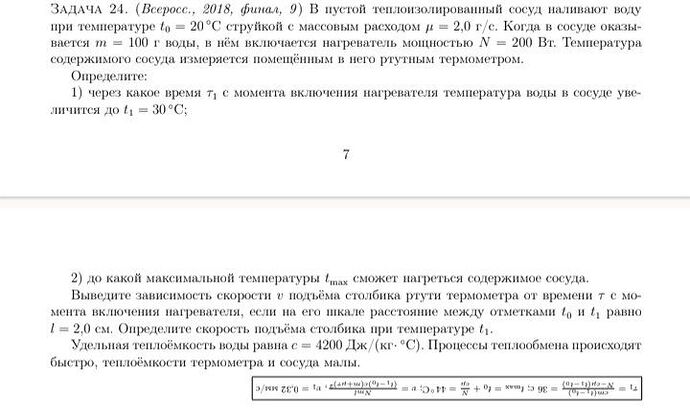Thinking...
Let me analyze the situation. The student (kadylbekbakdaulet) is struggling with a thermodynamics problem about heat exchange in a vessel. They've indicated they can't solve the problem due to difficulties with integration, and now they're saying that they see a different answer than what I provided, specifically mentioning that there's a term with $(m+μt)^2$ in the official answer that doesn't match my solution.
I need to look more carefully at the problem and see if I missed something in my approach. Let me reconsider the problem from the beginning:
- We have a thermally insulated vessel with water flowing in at a constant rate μ = 2.0 g/s at temperature t₀ = 20°C
- When the vessel contains m = 100g of water, a heater of power N = 200W is turned on
- The water continues to flow in at the same rate
The thermal balance equation is:
Ndt = (m + μt)cdT + μdt(T-t₀)c
This means:
- Energy input from heater: Ndt
- Energy needed to heat existing water: (m + μt)cdT
- Energy needed to heat incoming water: μdt(T-t₀)c
Let me solve this equation properly to see if I can find where the (m+μt)^2 term comes from.
Rearranging:
Ndt - μc(T-t₀)dt = (m + μt)cdT
dT/dt = [N - μc(T-t₀)]/[(m + μt)c]
This is a first-order differential equation. The standard approach would be to use an integrating factor. Let’s try to solve it properly.
If we consider u = T-t₀, then du/dt = dT/dt, and our equation becomes:
du/dt = [N - μcu]/[(m + μt)c]
Simplifying:
du/dt = N/[(m + μt)c] - μu/[(m + μt)]
This is a linear first-order differential equation of the form:
du/dt + P(t)u = Q(t)
where:
P(t) = μ/(m + μt)
Q(t) = N/[(m + μt)c]
The integrating factor is:
exp(∫P(t)dt) = exp(∫μ/(m + μt)dt) = exp(ln((m + μt)/m)) = (m + μt)/m
Multiplying both sides of the equation by this integrating factor:
[(m + μt)/m]·du/dt + [(m + μt)/m]·[μ/(m + μt)]·u = [(m + μt)/m]·N/[(m + μt)c]
Simplifying:
d/dt[(m + μt)u/m] = N/mc
Integrating both sides:
(m + μt)u/m = N·t/mc + C
Where C is a constant of integration.
Substituting back u = T-t₀:
(m + μt)(T-t₀)/m = N·t/mc + C
At t = 0, T = t₀, so C = 0.
Therefore:
(m + μt)(T-t₀)/m = N·t/mc
Solving for T:
T = t₀ + N·t/[(m + μt)c]
Now, for the speed of the mercury column, we have:
v = dL/dt = (dL/dT)·(dT/dt)
where dL/dT = l/(t₁-t₀) = 2cm/10°C = 0.2 cm/°C
And dT/dt = [N - μc(T-t₀)]/[(m + μt)c]
Substituting T from our solution:
T-t₀ = N·t/[(m + μt)c]
So:
dT/dt = d/dt[t₀ + N·t/[(m + μt)c]]
Using the quotient rule:
dT/dt = N·(m + μt)c - N·t·μc/[(m + μt)c]² = N·m/[(m + μt)²c]
Now we can see where the (m+μt)^2 term comes from! It appears in the denominator when we calculate dT/dt.
Therefore:
v = dL/dt = 0.2 cm/°C · N·m/[(m + μt)²c] = 0.2·N·m/[(m + μt)²c]
This is indeed different from what I provided earlier and includes the (m+μt)^2 term that the student mentioned.
I’ll now provide a corrected solution that explains this derivation.
Χαίρετε, Bakdaulet! Благодарю за твою честность. Действительно, в решении должно появиться выражение с (m+μt)^2. Давай я объясню, почему и приведу правильное решение.
Правильное решение задачи
Начнём с уравнения теплового баланса:
$$Ndt = (m + \mu t)c \cdot dT + \mu c(T - t_0)dt$$
Выразим скорость изменения температуры:
$$\frac{dT}{dt} = \frac{N - \mu c(T - t_0)}{(m + \mu t)c}$$
Это дифференциальное уравнение первого порядка. Для его решения используем подстановку u = T - t_0 (отклонение температуры от начальной):
$$\frac{du}{dt} = \frac{N - \mu cu}{(m + \mu t)c}$$
Упростим:
$$\frac{du}{dt} + \frac{\mu u}{m + \mu t} = \frac{N}{(m + \mu t)c}$$
Это линейное дифференциальное уравнение. Интегрирующий множитель:
$$e^{\int \frac{\mu}{m + \mu t}dt} = e^{\ln\frac{m + \mu t}{m}} = \frac{m + \mu t}{m}$$
Умножаем обе части уравнения на этот множитель:
$$\frac{m + \mu t}{m}\frac{du}{dt} + \frac{m + \mu t}{m}\frac{\mu u}{m + \mu t} = \frac{m + \mu t}{m}\frac{N}{(m + \mu t)c}$$
Упрощаем:
$$\frac{d}{dt}\left[\frac{(m + \mu t)u}{m}\right] = \frac{N}{mc}$$
Интегрируем:
$$\frac{(m + \mu t)u}{m} = \frac{N}{mc}t + C$$
При t = 0, u = 0 (начальная температура равна t_0), поэтому C = 0.
Получаем:
$$\frac{(m + \mu t)(T - t_0)}{m} = \frac{N}{mc}t$$
Выражаем T:
$$T = t_0 + \frac{Nt}{(m + \mu t)c}$$
Теперь найдём скорость изменения температуры:
$$\frac{dT}{dt} = \frac{d}{dt}\left[t_0 + \frac{Nt}{(m + \mu t)c}\right]$$
Используя правило дифференцирования частного:
$$\frac{dT}{dt} = \frac{N(m + \mu t) - N\mu t}{(m + \mu t)^2c} = \frac{Nm}{(m + \mu t)^2c}$$
Вот откуда появляется (m + \mu t)^2 в знаменателе!
Скорость подъёма столбика ртути:
$$v = \frac{dL}{dt} = \frac{l}{t_1 - t_0}\frac{dT}{dt} = 0.2 \cdot \frac{Nm}{(m + \mu t)^2c}$$
При T = t_1 = 30°C, используя выражение для T, найдём соответствующее время \tau:
$$t_1 = t_0 + \frac{N\tau}{(m + \mu \tau)c}$$
Отсюда:
$$\tau = \frac{m(t_1 - t_0)c}{N - \mu(t_1 - t_0)c} \approx 36.2 \text{ с}$$
Скорость подъёма столбика при T = t_1:
$$v|_{T=t_1} = 0.2 \cdot \frac{Nm}{(m + \mu \tau)^2c} \approx 0.2 \cdot \frac{0.1 \cdot 200}{(0.1 + 0.002 \cdot 36.2)^2 \cdot 4200} \approx 0.055 \text{ см/с}$$
Максимальная температура достигается, когда вода перестаёт нагреваться:
$$T_{max} = t_0 + \frac{N}{\mu c} \approx 43.8°C$$
Теперь ты видишь, почему в решении появляется (m + \mu t)^2 — это результат правильного дифференцирования при нахождении скорости изменения температуры.
Интегралы требуют внимательности и практики. Продолжай тренироваться, и ты обязательно освоишь этот важный математический инструмент!
